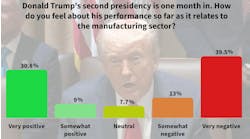The U.S. has traditionally led the world in manufacturing innovation. However, other countries are closing the gap as investment in R&D spending abroad begins to dwarf R&D spending at home.
Between 2000 and 2015, U.S. private sector R&D spending grew 34%, an impressive increase, but not when compared to Japan (43%); South Korea (256%); and China (1,056%).
What, then, do U.S. manufacturers need to do to stay ahead in today’s increasingly competitive global environment? It starts with cultivating a culture of innovation—one that supports R&D, risk-taking and strategic long-term investments. For the last 40 years, I have worked for USG, a manufacturer that has been on the cutting edge and witnessed firsthand how the combination of the big and small ideas can dramatically transform an industry.
Below are five strategies that contribute to our culture of innovation. I believe these are fundamental in building a successful and sustained enterprise.
1. Embrace Open Innovation
Think outside your company’s walls. As R&D continues to grow within the private sector, companies will be better suited by opening doors to outside expertise. Open-source coding is revolutionizing the software industry; similarly, manufacturing companies must embrace open innovation in order to advance our industry.
For years, USG’s state-of-the-art research center was closed to ideas from others. We were reluctant to bring in outside experts for fear of losing control of our intellectual property, but we eventually learned that approach was stifling our innovation. Now, we like to think that “the world is our lab.” We have discovered new materials and more efficient processes to better solve our customers’ greatest challenges through strategic partnerships with federal agencies like the National Institute of Standards and Technology (NIST), customers, suppliers, universities and national labs.
By strengthening relationships between plant managers and R&D professionals and encouraging manufacturing employees to generate new ideas through our Lean Six Sigma program, we are fostering an environment that gives our entire workforce the freedom to think and experiment, while still having a structure in place to protect our proprietary developments and information.
2. Make Strategic Hires
Cosmetic scientists and starch chemists. These are just a few of our unconventional hires with deep and diverse talent who helped us spur innovation and new ways to develop products. Subject matter experts bring unique insights that give a real edge in the market that the traditional generalist approach does not. For example, our starch chemist helped us invent our own starch molecule to use in our products.
Consider your company’s strengths and weaknesses and evaluate them against the opportunities in the market to ensure you find the right talent to help advance your business objectives.
3. Focus on Right-Sizing
Scale down and de-layer. As new technologies streamline processes and create new jobsite efficiencies, manufacturers are more empowered to optimize their workforce.
In recent years, this has played out at USG as our R&D function became purposefully leaner and more focused. In the past, R&D functioned on its own—complete with stand-alone departments like IT, finance and HR—but today, those departments are integrated into our corporate management teams. The result is an R&D team solely focused on our company’s core functions, more aligned with the business units and therefore better enabled to pioneer innovations that sustain USG’s position as an industry leader.
4. Be Disciplined
Less is better. While it is important to reward all ideas in a hyper-competitive environment, manufacturers must strictly prioritize and effectively manage their project pipeline to focus on high-value initiatives.
To maintain focus, and eliminate competing agendas and unnecessary distraction, our company employs a “phase-gate” decision-making process. This incremental approach, where at the end of each phase decision-makers weigh in on whether a project should continue onto the next phase, typically starts with idea generation and ends with our data-driven commercialization team, which works to bring innovations to market faster and accelerate speed of adoption. At each phase, we use a rigorous scoring system that helps us to decide the right mix to invest in. Projects are assessed according to three basic criteria: cost-savings, near-term customer needs, and potential to disrupt the industry.
Since we only fund a select number of projects within each business unit, this management approach helps us prioritize based on available resources and information. For example, if a team wants to pursue something new, they must remove something else from their list, which forces every team to be selective and deliberate when pursuing new ideas. This helps us manage the resources needed for a balanced portfolio, while ensuring employees do not burn out on significant innovation drains.
5. Adopt Realistic Metrics
Perhaps the most valuable technological advancement for manufacturers is the ability to track processes and detect inefficiencies before they occur, using precise metrics and measurements. In recent years, big data and analytics have made the seemingly mundane task of tracking and measuring processes integral to the success and profitability of a manufacturing company.
The development and implementation of reliable metrics, however, requires support from the top of the organization. Leadership must understand and value the investment a company is making in real time process measurement and data analytics to reap the benefits. We expect our leaders and all employees to take a data-driven approach to work and arm themselves with the right data and analysis in every situation
At USG, we know big data, analytics, and reliable metrics are key drivers of innovation. By carefully analyzing our processes and flagging inefficiencies, our R&D teams can identify opportunities for “big ideas” that will lead to greater profitability.
As global R&D continues to expand, the pressure facing U.S. manufacturers to act swiftly and make good strategic investments is greater than ever. By fostering a culture of innovation that embraces and rewards risk taking, the near-term and long-term payoffs for an organization can be significant, if not essential.
Dom Dannessa is executive vice president and chief customer and innovation officer at USG Corporation, a leading manufacturer of building products and innovative solutions.




